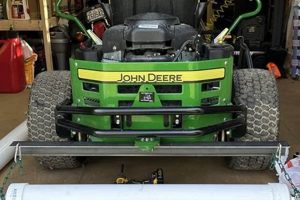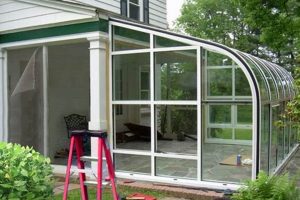A pre-packaged collection of components designed to facilitate the construction of a backyard water feature is often desired by homeowners. These collections typically include a pond liner, pump, filter, and tubing, providing a convenient all-in-one solution. As an example, a small package may contain a flexible PVC liner, a submersible pump rated for a specific gallon capacity, a biological filter unit, and connection hoses.
These product offerings provide numerous advantages, simplifying the pond-building process and reducing the guesswork involved in selecting compatible components. Benefits include cost savings compared to purchasing individual parts, simplified installation due to pre-selected and matched equipment, and reduced time investment. Historically, constructing these features required extensive research and sourcing of individual components, making the packaged solution a more accessible option for novice pond enthusiasts.
Understanding the factors that influence component selection, installation techniques, and ongoing maintenance procedures is essential for successful implementation. This article will further explore key considerations such as liner material selection, pump sizing, filtration methods, and long-term pond management strategies.
Essential Guidance for Constructing Your Water Feature
Successfully establishing a backyard water feature involves careful planning and meticulous execution. The following guidelines provide essential information to ensure a thriving aquatic environment.
Tip 1: Liner Selection: The appropriate liner material is paramount to prevent water loss. Opt for a durable, UV-resistant liner, such as EPDM rubber, chosen based on the pond’s dimensions and anticipated water volume. Proper underlayment is crucial to protect the liner from punctures.
Tip 2: Pump Sizing: An appropriately sized pump circulates water effectively and maintains water quality. Determine the required flow rate based on pond volume and desired turnover rate. A pump with insufficient capacity will compromise filtration, while an oversized pump may create excessive turbulence.
Tip 3: Filtration Implementation: Adequate filtration is essential for removing debris and maintaining water clarity. Mechanical filtration removes particulate matter, while biological filtration supports beneficial bacteria that consume harmful ammonia and nitrites. Consider incorporating both types of filtration into the system.
Tip 4: Biological Balance: Establishing a balanced ecosystem requires cultivating beneficial bacteria. These microorganisms convert harmful waste products into less toxic substances. Supplementing the pond with beneficial bacteria starters can accelerate this process, particularly during initial setup.
Tip 5: Plant Integration: Aquatic plants contribute to a healthy pond environment by providing oxygen, absorbing nutrients, and offering shelter for aquatic life. Select plant species that are appropriate for the local climate and the pond’s depth. Ensure plants are non-invasive and do not disrupt the ecosystem.
Tip 6: Gradual Filling Process: Introduce water gradually to allow the liner to settle and conform to the pond’s contours. This slow filling process minimizes the risk of liner stress or displacement.
Tip 7: Monitoring Water Parameters: Regularly monitor water parameters such as pH, ammonia, nitrite, and nitrate levels. Deviations from acceptable ranges indicate potential imbalances that require corrective action. Water testing kits are readily available and offer a convenient means of assessment.
By adhering to these guidelines, individuals can create a flourishing aquatic environment that enhances their outdoor living space. Consistent monitoring and maintenance are crucial for long-term success.
The following section will address frequently encountered challenges and provide troubleshooting solutions for common pond-related issues.
1. Liner Material Durability
The longevity and structural integrity of a backyard water feature constructed from a do-it-yourself package are directly contingent upon the durability of the included liner material. Compromised liner integrity results in water loss, ecosystem instability, and eventual failure of the intended aquatic environment. A kit’s value proposition is substantially diminished if the liner exhibits premature degradation or susceptibility to punctures. For instance, a thin, low-grade PVC liner within a lower-priced kit may exhibit cracking and leaks within a single season, necessitating costly repairs or replacement, thereby negating any initial savings.
Selection of appropriate liner materials, such as EPDM rubber or reinforced polyethylene, directly impacts the overall maintenance requirements and long-term cost-effectiveness of the pond. EPDM, known for its UV resistance and flexibility, is less prone to cracking under temperature fluctuations and physical stress, resulting in a more robust and reliable water containment solution. In contrast, inadequate or improperly installed liners can lead to soil erosion around the pond’s perimeter, requiring frequent water refills and disrupting the delicate balance of the aquatic ecosystem. Consider a scenario where rocks or roots puncture a substandard liner, causing a slow but persistent leak that depletes water levels and stresses aquatic life.
Therefore, assessment of liner material specifications within a pond construction package is paramount. This evaluation encompasses thickness, tensile strength, and resistance to environmental factors. While initial cost may be a primary consideration, the long-term financial and ecological implications of liner failure necessitate prioritizing durable materials. The selection process should consider the intended use of the pond, the local climate, and the potential for physical damage from landscaping or wildlife. Ignoring liner quality is a false economy, as the costs associated with repairs, replacements, and ecosystem disruption far outweigh the initial savings.
2. Pump Capacity Assessment
Pump capacity assessment is a critical determinant of a backyard pond’s overall health and aesthetic appeal, particularly when considering a do-it-yourself pond package. The pump’s ability to circulate water effectively directly influences oxygen levels, filtration efficiency, and the prevention of stagnant conditions that can foster algae growth and compromise aquatic life. Inadequate pump capacity results in poor water quality, leading to fish stress or mortality, reduced plant vitality, and an unsightly pond environment. Consider a small package featuring a pump incapable of processing the pond’s total water volume within a reasonable timeframe. This deficiency inevitably leads to a build-up of debris and toxins, creating an uninhabitable ecosystem for desired flora and fauna. Conversely, an oversized pump wastes energ
y and potentially disrupts the pond’s delicate balance, creating excessive turbulence that uproots plants and disturbs sediment.
The selection of a pond construction package must, therefore, prioritize accurate pump sizing predicated on the pond’s dimensions, volume, and intended inhabitants. A well-defined pump capacity assessment considers factors such as the pond’s surface area, depth, and the presence of waterfalls or fountains, which require additional head pressure. Example: If a user purchases a kit advertised for a 500-gallon pond but includes a pump rated for only 250 gallons, the system will invariably fail to maintain optimal water quality. A proper assessment also accounts for the filter’s flow rate requirements, ensuring the pump can adequately supply the filtration system without compromising its performance. Understanding the relationship between pump capacity and filter efficiency is essential for achieving sustained water clarity and minimizing maintenance demands. Pre-packaged solutions often provide generic pump recommendations that may not adequately address the specific needs of a particular pond installation, underscoring the importance of individual evaluation and potential pump upgrade.
In summary, pump capacity assessment represents a foundational element in the successful implementation of a pond construction package. Failure to adequately assess and address this factor leads to compromised water quality, ecosystem instability, and diminished aesthetic value. Therefore, prospective pond builders should critically evaluate the pump specifications provided within a package, comparing them against the specific requirements of their intended pond design. Prioritizing pump capacity optimization ensures a thriving aquatic environment and minimizes long-term maintenance challenges.
3. Filtration System Efficiency
Filtration system efficiency is paramount to the successful establishment and long-term maintenance of a backyard water feature created with a do-it-yourself pond package. The effectiveness of the filtration directly impacts water clarity, aquatic life health, and overall aesthetic appeal. Inadequate filtration leads to algae blooms, accumulation of debris, and the build-up of harmful toxins, ultimately compromising the intended aquatic ecosystem.
- Mechanical Filtration Efficacy
Mechanical filtration removes particulate matter, such as leaves, sediment, and uneaten food, preventing cloudiness and reducing the load on biological filters. The efficiency of mechanical filtration depends on the filter media’s pore size and flow rate. For example, a coarse sponge filter may effectively remove large debris, but a finer filter pad is required to capture smaller particles. In a pond package, a poorly designed or undersized mechanical filter will quickly clog, reducing water flow and allowing debris to accumulate, negating its intended benefit.
- Biological Filtration Capacity
Biological filtration relies on beneficial bacteria to convert harmful ammonia and nitrites into less toxic nitrates. The capacity of a biological filter is determined by the surface area available for bacterial colonization and the oxygen levels within the filter media. In a pond package, a bio-filter lacking sufficient surface area or proper aeration will be unable to effectively process waste, leading to elevated ammonia and nitrite levels, which are toxic to fish. An example is a small, un-aerated bio-filter in a heavily stocked pond, resulting in significant fish mortality.
- UV Clarifier Effectiveness
UV clarifiers use ultraviolet light to kill algae and bacteria suspended in the water. The effectiveness of a UV clarifier depends on the wattage of the UV lamp and the flow rate of water passing through the unit. If the flow rate is too high, the UV light may not have sufficient contact time with the water to effectively kill algae, resulting in green water. A poorly sized or malfunctioning UV clarifier included in a pond package will fail to control algae growth, leading to aesthetic issues and potentially harming aquatic life by reducing oxygen levels.
- Filter Maintenance Requirements
The long-term efficiency of any filtration system depends on regular maintenance. Mechanical filters require periodic cleaning to remove accumulated debris, while biological filters may need occasional rinsing to prevent clogging. A pond package with a difficult-to-access or complicated filter design will discourage regular maintenance, leading to a decline in filtration efficiency over time. For instance, a filter that requires complete disassembly for cleaning may be neglected, resulting in a build-up of sludge and reduced water flow.
These facets highlight the importance of a well-designed and properly maintained filtration system in any pond construction package. The combination of efficient mechanical, biological, and UV filtration, coupled with ease of maintenance, ensures a healthy and aesthetically pleasing aquatic environment. Compromises in any of these areas can lead to significant problems and negate the benefits of constructing a backyard water feature. The consideration of adequate filtration cannot be overstated when installing any water feature system.
4. Ecosystem Biological Balance
The successful establishment of a backyard water feature via a do-it-yourself package is intrinsically linked to the maintenance of ecosystem biological balance. This balance represents a delicate equilibrium between aquatic life, plants, beneficial bacteria, and water chemistry. A disruption in this equilibrium manifests as algae blooms, elevated toxin levels, and diminished aesthetic appeal. A pond construction package, by its nature, introduces a controlled environment; however, the long-term viability hinges on establishing a self-sustaining ecosystem. For instance, a package may include aesthetically pleasing plants, yet fail to account for the nutrient load these plants introduce, leading to algae overgrowth due to insufficient beneficial bacteria to process the excess nutrients. This results in a murky, unattractive pond requiring frequent intervention, contrary to the intended low-maintenance design.
The components included within the packaged solution either contribute to or detract from the establishment of biological equilibrium. The presence of an appropriately sized biological filter, for example, directly facilitates the conversion of harmful ammonia and nitrites into less toxic nitrates. Conversely, the absence of adequate aeration compromises the efficiency of the biological filter, inhibiting the growth of beneficial bacteria. Practical application of this understanding involves critically evaluating the filter capacity relative to the anticipated bioload of the pond (i.e., the organic waste produced by fish and decaying plant matter). Furthermore, selecting appropriate plant species, avoiding overstocking with fish, and regularly removing decaying organic matter are crucial for maintaining balance. Ignoring these considerations leads to a cascade of negative effects, including increased disease susceptibility in fish, reduced plant health, and the need for chemical interventions to control algae.
In conclusion, ecosystem biological balance is not merely a desirable attribute but a fundamental requirement for the long-term success of any pond construction package. Achieving and ma
intaining this balance necessitates a holistic understanding of the interconnected relationships within the aquatic environment and a proactive approach to managing the factors that influence its stability. Challenges include accurately assessing the pond’s bioload and selecting components that effectively mitigate its impact. Prioritizing ecosystem biological balance ensures a thriving, low-maintenance, and aesthetically pleasing water feature, fulfilling the intended purpose of the pond construction package.
5. Maintenance Schedule Adherence
Maintenance schedule adherence is a critical factor determining the longevity and aesthetic quality of a water feature established using a do-it-yourself pond package. Disregarding a structured maintenance plan leads to system degradation, ecosystem imbalance, and increased long-term costs, undermining the initial benefits of the product.
- Water Quality Monitoring Frequency
Regular water quality monitoring is essential for identifying imbalances before they escalate. Testing for parameters such as pH, ammonia, nitrite, and nitrate provides early warning signs of potential problems. A neglected testing schedule allows imbalances to worsen, leading to algae blooms, fish stress, and plant decline. For example, infrequent testing may miss a spike in ammonia levels caused by decaying organic matter, resulting in fish mortality if left unaddressed.
- Filter Cleaning Protocols
Filters, whether mechanical or biological, require periodic cleaning to maintain optimal performance. Accumulated debris in mechanical filters reduces water flow, while clogged biological filters inhibit beneficial bacteria. A deferred cleaning schedule leads to reduced filtration efficiency and increased pollutant levels. Consider a scenario where a mechanical filter is not cleaned regularly, causing it to become completely clogged and rendering the entire filtration system ineffective.
- Pond Debris Removal
Accumulated organic matter, such as leaves and decaying plants, decomposes and releases harmful substances into the pond. Regular removal of this debris prevents the build-up of toxins and reduces the nutrient load that fuels algae growth. Neglecting debris removal leads to a murky pond with compromised water quality. For instance, allowing a thick layer of leaves to accumulate at the bottom of the pond over the winter will result in a surge of nutrients released in the spring, triggering an algae bloom.
- Equipment Inspection and Upkeep
Pumps, UV clarifiers, and other equipment require periodic inspection and maintenance to ensure proper functioning. Neglecting equipment upkeep can lead to premature failure and system downtime. For example, a pump left running without periodic cleaning may overheat and burn out, requiring costly replacement and disrupting the pond ecosystem.
Adhering to a well-defined maintenance schedule, encompassing water quality monitoring, filter cleaning, debris removal, and equipment upkeep, is essential for maximizing the lifespan and aesthetic appeal of a pond constructed from a do-it-yourself package. Prioritizing consistent maintenance mitigates potential problems, reduces long-term costs, and ensures a thriving aquatic environment.
Frequently Asked Questions
This section addresses common inquiries regarding pond construction packages, providing clarity on aspects ranging from component selection to long-term maintenance considerations.
Question 1: What constitutes a typical DIY pond kit?
A standard package generally includes a pond liner (typically PVC or EPDM rubber), a submersible pump, a filtration system (mechanical and/or biological), tubing for water circulation, and occasionally, pre-formed edging or decorative elements.
Question 2: How is pond liner size determined when selecting a DIY pond kit?
Liner size is calculated based on the intended pond’s length, width, and depth. The following formula is generally applied: Liner Width = Pond Width + (2 x Pond Depth) + 2 feet (for overlap); Liner Length = Pond Length + (2 x Pond Depth) + 2 feet (for overlap). It is crucial to account for adequate overlap to secure the liner edges.
Question 3: What are the critical considerations when sizing the pump included in a DIY pond kit?
Pump sizing is based on the pond’s volume and desired turnover rate. A general guideline is to select a pump capable of circulating the entire pond volume at least once every two hours. Head height (the vertical distance water must be pumped) also impacts pump performance and must be considered.
Question 4: What type of filtration is essential for a healthy pond ecosystem facilitated by a DIY pond kit?
Both mechanical and biological filtration are crucial. Mechanical filtration removes particulate matter, while biological filtration supports beneficial bacteria that convert harmful ammonia and nitrites into less toxic nitrates. Some packages may also include UV clarifiers to control algae growth.
Question 5: How frequently should the filtration system be maintained in a pond established using a DIY pond kit?
Maintenance frequency depends on factors such as pond size, fish population, and plant density. Generally, mechanical filters require cleaning every 1-2 weeks, while biological filters may only need rinsing every few months. Regular water testing helps determine the need for more frequent maintenance.
Question 6: What common challenges are encountered when using DIY pond kits, and how can they be mitigated?
Common challenges include inadequate liner sealing, improper pump sizing, and insufficient filtration. Mitigation strategies include careful liner installation, accurate pump capacity calculation, supplementing the provided filtration with additional units if necessary, and regular monitoring of water parameters.
Proper planning and diligent execution are paramount for realizing a thriving backyard aquatic feature through utilization of a pond construction package. Failure to address the aforementioned aspects may result in ecosystem imbalances and escalated maintenance demands.
The concluding section will summarize the core principles discussed throughout this article, emphasizing critical insights for success.
Conclusion
This article has explored the multifaceted considerations surrounding the implementation of a diy pond kit. Emphasis has been placed on the significance of liner material durability, accurate pump capacity assessment, efficient filtration system design, the attainment of ecosystem biological balance, and diligent adherence to a maintenance schedule. These factors are not merely recommendations but rather essential components of a successful pond construction endeavor.
The enduring success of a backyard water feature hinges upon a comprehensive understanding and meticulous application of these principles. Thorough research, careful planning, and consistent maintenance are crucial for achieving a thriving and aesthetically pleasing aquatic environment. Failure to address these fundamental aspects will inevitably lead to compromised water quality, ecosystem instability, and diminished aesthetic value. The responsible implementation of the principles outlined herein ensures a sustainable and enjoyable water feature for years to come.







